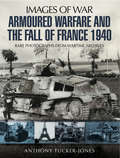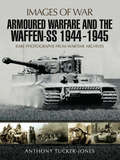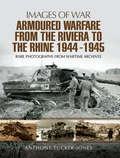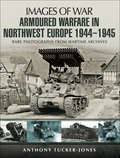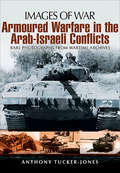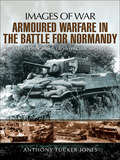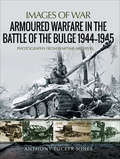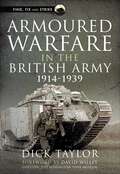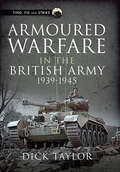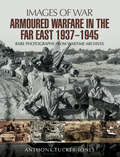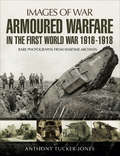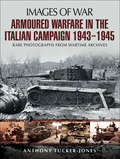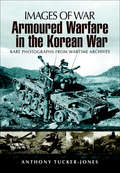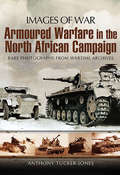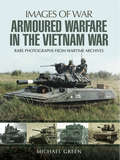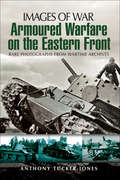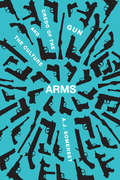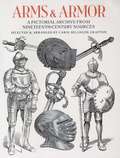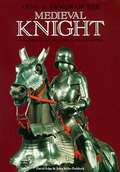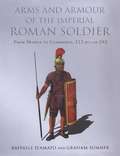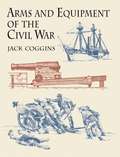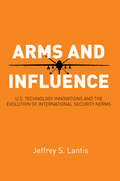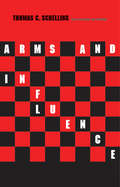- Table View
- List View
Armoured Warfare and the Fall of France 1940: Rare Photographs From Wartime Archives (Images of War)
by Anthony Tucker-JonesAt 21:00 on 9 May 1940 Codeword Danzig was issued alerting Adolf Hitler's airborne troops that they were about to spearhead an attack on Belgium and the Netherlands. The following day his blitzkrieg rolled forward striking the British Expeditionary Force and the French armies in Belgium and in northern France at Sedan. The desperate attempts of the allied armies to stem the Nazi tide proved futile and, once their reserves had been exhausted and the remaining forces cut off, Paris lay open. By early June, it was all over - trapped British, Belgian and French troops were forced to evacuate Dunkirk, Calais and Boulogne and the defeated French army agreed to an armistice leaving the country divided in two. This dramatic story is shown in a sequence of over 150 historic photographs that Anthony Tucker-Jones he has selected for this memorable book. The images he has chosen cover every aspect of this extraordinary campaign, but his main focus is on the vital role played by the armoured fighting vehicles of both sides. The book is a graphic record of the destruction wrought by the Wehrmacht's lightning offensive through the Low Countries and France.
Armoured Warfare and the Waffen-SS, 1944–1945: Rare Photographs from Wartime Archives (Images of War)
by Anthony Tucker-JonesA pictorial history of Nazi Germany&’s Waffen-SS panzer and panzergrenadier divisions during the final years of World War II. Over 150 wartime photographs give a graphic snapshot of the dramatic tank battles fought by the Waffen-SS panzer and panzergrenadier divisions during 1944-5 on both the Eastern and Western fronts. By this stage of the Second World War these formations were at the height of their powers and took part in major armoured operations in Russia, France, the Netherlands, and Poland. As the Wehrmacht retreated the Waffen-SS played an increasingly important role. Most notably their panzers prolonged the war by staving off defeat at Arnhem and Wolomin, stabilizing both the Western and Eastern fronts at critical points in the fighting. The photographs and the accompanying narrative record the contrasting conditions they faced on each battlefront and the weapons and equipment they used, especially the armored vehicles, including the Tiger and Panther tanks, which were among the best designs the Germans produced. But they also record the crimes committed by members of the Waffen-SS against civilians and captured enemy soldiers during the series of brutal, often desperate operations mounted to stave off German defeat. Anthony Tucker-Jones&’s photographic history is a fascinating introduction to these elite units during the final phase of the fighting in Europe.
Armoured Warfare from the Riviera to the Rhine, 1944–1945 (Images of War)
by Anthony Tucker-JonesWhile the Allied armies were deadlocked with the Germans in Normandy after D-Day and even as they broke out and began their long advance, another campaign was being fought against the Germans in southern France and it is this campaign, which is often neglected in accounts of the liberation of Europe, that is the subject of Anthony Tucker-Joness latest photographic history. In a sequence of over 150 wartime photographs he tells the story, from the amphibious invasion of the French Riviera Operation Dragoon to the battle at Montelimar, the forcing of the Belfort gap, the destruction of German resistance in the Colmar pocket and the entry of Allied forces into southern Germany. His concise narrative gives a graphic overview of each phase of the operations, and the selection of photographs shows the American, French and German forces in action. The mechanized and armoured units and their equipment are a particular feature of the book. The photographs are a valuable visual record of the tanks, guns, jeeps and trucks the most up-to-date military vehicles and weaponry of the time as they moved along the roads and through the towns and countryside of southern France.
Armoured Warfare in Northwest Europe, 1944–1945: Rare Photographs from Wartime Archives (Images of War)
by Anthony Tucker-JonesThis latest volume in Anthony Tucker-Joness series of photographic histories of armored warfare records in graphic detail the role played by tanks, infantry fighting vehicles and self-propelled artillery during the decisive campaign in northwest Europe in 1944-5. In a sequence of over 200 archive photographs he shows how American, British, Canadian, and Polish armored divisions spearheaded the assault on the Third Reich, and how the Wehrmacht mounted a desperate armored defense. Tanks were required to operate in the dust of Normandy, the mud and waters of the Scheldt and Rhine rivers and the snows of the Ardennes and the forests of Germany. A succession of crucial armored engagements was fought during the D-Day landings, Operation Goodwood and the struggle for the Bourgubus ridge, the Falaise pocket, the Seine crossing, Arnhem, the German attack in the Ardennes, the Rhine crossing, in the Reichswald and during the rearguard actions and the last-ditch tank battles fought by the panzers in the Ruhr before the German surrender. Anthony Tucker-Joness photographic survey of the ultimate tank battles of the Second World War illustrates the range of armored fighting vehicles that were developed during the conflict, and it features the specialized vehicles deployed in Europe for the first time such as the Buffalo, DUKW, Weasel and Terrapin.
Armoured Warfare in the Arab-Israeli Conflicts: Rare Photographs From Wartime Archives (Images of War)
by Anthony Tucker-JonesThe latest volume in Anthony Tucker-Joness series of books on armoured warfare in the Images of War series is a graphic account of the development of armoured forces in the Arab and Israeli armies from 1948 to the present day. In a sequence of over 200 archive photographs he tells the story of the role armour played in Arab-Israeli conflicts over the last sixty years, from the initial battles of 1948, through the Suez Crisis, the Six Day War, the Yom Kippur War, the Israeli invasion of Lebanon in 1982 and the Israeli attack on Hamas in Gaza in 2008.In all these clashes armoured vehicles played a prominent, sometimes decisive part. As the photographs show, an extraordinary range of Second World War and post-war tanks, armoured cars and armoured personnel carriers was deployed by all sides. Russian T-34s, SU-100s, T-54/55s, T-62s and T-72s were imported from the Eastern Bloc by the Egyptians and Syrians. Shermans, Pattons, Centurions and AMX-13s were imported from the West by the Israelis. In addition, the Israelis developed modified hybrids such as the Sherman/Isherman, the Shot, Magach and Sabra, and they produced to their own design their main battle tank, the Merkava. Anthony Tucker-Joness photographic survey is an excellent introduction to late-twentieth-century armoured warfare, and it gives a fascinating insight into the military history of Israel and its Arab neighbours.
Armoured Warfare in the Battle for Normandy: Rare Photographs from Wartime Archives (Images of War)
by Anthony Tucker-JonesThis fully illustrated WWII history offers a vivid look at the armored vehicles used by Allied and Nazi forces during D-Day and the Normandy Campaign.The remarkable photographs collected here illustrate in graphic detail the role armor played in the Allied D-Day landings and the liberation of occupied France—as well as the skill and tenacity of the German panzer units that confronted them. The struggle gave rise to a sequence of battles that were among the most intense, and critical, of any fought in the Second World War. Anthony Tucker-Jones traces the course of the armored campaign through these striking wartime photographs: the D-Day landings, the first clashes of the opposing tanks and anti-tank guns, then the Allied operations that culminated in the Allied breakthrough and the destruction of the German 5th Panzer Army at Falaise. The images offer a fascinating inside view of the fighting itself and of the widespread destruction it caused. But they also record the routines of tank warfare, and give a vivid impression of the experience of the tank crews of the day and of the tanks they operated, including the German Mk IVs, Panthers, and Tigers, and the Allied Shermans, Churchills and specialized tanks, such as Hobart&’s Funnies, that confronted each other in France.
Armoured Warfare in the Battle of the Bulge, 1944–1945: Rare Photographs from Wartime Archives (Images of War)
by Anthony Tucker-JonesThe Battle of the Bulge took the Allied armies by surprise in 1944. It was a result of the extraordinary recovery of Hitlers panzer divisions following crushing defeats on the Eastern and Western fronts. In a daring offensive he hoped his panzers would unhinge the American and British push on the Rhine by charging through the Schnee Eifel, thereby prolonging the war. The consequence was one of the best-known battles of the entire conflict, and Anthony Tucker-Jones's photographic history is the ideal introduction to it. The story is told through a sequence of revealing contemporary photographs and a concise text. They give a sharp insight into the planning and decision-making, the armored forces involved, the terrain and the appalling mid-winter conditions, the front-line fighting and the experience of the troops involved. The armored battle, which was critical to the outcome, is the main focus. Through a massive tank offensive the Germans aimed to cut through the US 1st Army to Antwerp and Brussels, in the process trapping three Allied armies. The confusion and near collapse of the Americans as their defenses were overrun is vividly recorded in the photographs, as is their resistance and recovery as the German spearheads were slowed, then stopped.
Armoured Warfare in the British Army, 1914–1939 (Find, Fix and Strike)
by Richard TaylorThis is the first volume in a three-volume illustrated history of the evolution of armored manoeuvre warfare in the British army, covering the period from 1914 until 1939. Author Dick Taylor’s tour de force covers the evolution of the tank and armored cars in response to the specific conditions created by trench warfare, the history of the use of tanks during the war, as well as the critical period between the wars in which the tank was both refined and neglected. He also looks in detail at the amalgamations and mechanization of the horsed cavalry which led to the formation of the Royal armored Corps in 1939. His detailed and absorbing narrative covers the social and human aspects of the story as well as the technology, and explains how the nation that invented and first fielded the tank in 1916 struggled to maintain the lead after the Armistice.
Armoured Warfare in the British Army 1939–1945 (Find, Fix and Strike)
by Dick TaylorThe second volume in Dick Taylor’s three-volume illustrated history of the evolution of armored maneuver warfare in the British army covers the period of the Second World War, in which the tank came of age and developed into the principal land weapon of decision. He describes how, during the first half of the war, the British army came close to disaster from the armored warfare perspective and how the bitter lessons of failure were learned in time to deliver success in 1944 and 1945. As well as providing a fascinating overview of the tactical use of armor during the main campaigns, he considers such much-neglected aspects as the role of training and organization, officer selection and recruitment, and the mechanization of other arms. His wide-ranging book also features extensive, well-laid-out tables giving key information about British armor during this period. This expert account quotes heavily from the vivid recollections of soldiers who served in armor, and is not afraid to criticize as well as praise.
Armoured Warfare in the Far East, 1937–1945: Rare Photographs From Wartime Archives (Images of War)
by Anthony Tucker-JonesAnthony Tucker-Jones's photographic history is a fascinating visual introduction to the armoured battles of the Second World War in the Far East and Asia-Pacific regions, from 1937 to 1945. In contrast to the experience of the armies that fought in Europe and North Africa, in the Far East tanks remained an infantry support weapon, and their role is often neglected in histories of the conflict. Japanese armour confronted tanks deployed by the Chinese, Russians, British and Americans. Early in the war, against Chinese forces which lacked armour, the Japanese had some success, but their light and medium tanks were no match for their Allied counterparts. Later Japanese designs were better armed, but they were built in such small numbers that they could do little to stem the Allied advance. The role of armoured vehicles in each theatre of the war in the Far East is shown in a selection of over 150 rare wartime photographs that record armour in action in China, Manchuria, Mongolia, Malaya, Burma and during the battles fought for the Pacific islands.
Armoured Warfare in the First World War 1916-18: Rare Photographs From Wartime Archives (Images of War)
by Anthony Tucker-JonesA hundred years ago, on 15 September 1916, on the Western Front during the Battle of the Somme, the tank made its debut on the battlefield. The first tanks were crude, unreliable, vulnerable weapons, but they changed the character of land warfare forever, and Anthony Tucker-Jones's photographic history of these pioneering armored vehicles is the ideal introduction to them. In a selection of over 150 archive photographs he offers a fascinating insight into the difficult early days of this innovative new weapon, describing its technical history and its performance in combat. While the Battle of Cambrai in 1917 is often held up as the first large-scale tank battle, tanks had already served at Flers-Courcelette on the Somme, during the Nivelle offensive and the battles of Messines and Passchendaele. His book shows that the development of the tank was fraught with technical obstacles and battlefield setbacks. It was invented by the British and the French at almost the same time to help break the deadlock of trench warfare, and the British deployed it first in 1916. Belatedly the Germans followed the British and French example. The initial designs were continuously refined during two years of intense warfare. Finding the right balance between power and weight, getting the armament right, and working out the best tactics for tanks on the battlefield was a tricky, often deadly business.
Armoured Warfare in the Italian Campaign, 1943–1945: Rare Photographs from Wartime Archives (Images of War)
by Anthony Tucker-JonesThis WWII pictorial history illustrates the wide array of armored vehicles deployed by Allied and Axis powers in Italy.The Second World War campaigns in North Africa, on the Eastern Front and in northwest Europe were dominated by armored warfare, but the battles in Italy were not. The Italian peninsula&’s mountainous terrain was best suited to an infantry war. Yet from the Allied landings in Sicily in 1943 to the German surrender after the crossing of the Po in 1945, tanks, self-propelled guns and armored cars were essential elements in the operations of both sides. Anthony Tucker-Jones&’s selection of rare wartime photographs shows armor in battle at Salerno, Anzio and Monte Cassino, during the struggle for the Gustav Line, the advance on Rome and the liberation of northern Italy. These dramatic images reveal the full array of Axis and Allied armored vehicles that was deployed, including German Panzers, Panthers, and Tigers and Allied Stuarts, Chafees, Shermans and Churchills. They also vividly illustrate the Italian landscapes over which the campaign was fought and the grueling conditions endured by the men who fought in it.
Armoured Warfare in the Korean War: Rare Photographs from Wartime Archives (Images of War)
by Anthony Tucker-JonesAfter the Second World War, military analysts thought that the only place significant armored forces were ever likely to confront each other again was in central Europe where the Nato alliance would fend off the Soviet Red Army. Then during the Korean War of 1950-53 both sides deployed large numbers of armored fighting vehicles, and this neglected aspect of the conflict is the subject of Anthony Tucker-Joness photographic history. Korea, with its rugged mountains, narrow passes, steep valleys and waterlogged fields was not ideal tank country so the armor mainly supported the infantry and rarely engaged in battles of maneuver. Yet the wide variety of armor supporting UN and North Korean forces played a vital if unorthodox role in the swiftly moving campaigns. For this fascinating book over 180 contemporary photographs have been selected to show Soviet-built T-34/85s and Su-76s, American M4 Shermans, M26 Pershings and M46 Pattons, and British Cromwells and Centurions in action in one of the defining conflicts of the Cold War.
Armoured Warfare in the North African Campaign: Rare Photographs from Wartime Archives (Images of War)
by Anthony Tucker-JonesThe North African campaign, the struggle of the Italians and Germans against the Allies in Egypt, Libya and Tunisia between 1940 and 1943, was a war of movement and maneuver, of dramatic changes of fortune, and it was a war in which mechanized forces—tanks in particular—excelled. Compared with the heavily populated landscapes of northwest Europe, the empty open spaces of North Africa appeared to be ideal operating terrain for tanks, yet the harsh desert conditions tested men and machinery to the limit, as Anthony Tucker-Jones demonstrates in this remarkable selection of wartime photographs.The use of armor during the entire course of the campaign is covered, from the initial Italian offensive, the arrival of Rommels Panzergruppe Afrika, the battles fought along the North African shore which culminated in El Alamein, then the Allied advance into Tunisia which led to the final defeat of the German and Italian armies.The images give a fascinating inside view of combat, but they also reveal the daily routines of tank warfare 65 years ago, and give a vivid impression of what it was like to fight in and live with the tanks of the day the German Mk IIIs and Mk IVs and the Tiger, the British Matildas and Valentines and the American Grants and Shermans that contributed so much to the Allied victory. Training, maintenance, transportation and supply are shown, as are the daily lives of the tank crews and extreme conditions in which they worked and fought.
Armoured Warfare in the Vietnam War: Rare Photographs From Wartime Archives (Images of War)
by Michael GreenThis pictorial history of the Indochina and Vietnam Wars captures the range of armored warfare used in the region through rare wartime photographs. The two conflicts that engulfed Indochina and Vietnam in the decades after World War II are generally thought of as infantry wars. But in fact, they both involved a significant amount of armored warfare. In this fully illustrated volume, military expert and Vietnam veteran Michael Green describes the many kinds of armored vehicles deployed and their contributions in combat. The ill-fated French Expeditionary Force of the Indochina War was largely equipped with World War II era American tanks—including M3 and M5 Stuart, M4 Sherman and M24 light tanks—as well as armored cars and half-tracks. Most of these eventually went to the Army of the Republic of Vietnam, but were outdated and ineffective due to lack of logistics and training. The US Army and Marine Corps build-up in the 1960s saw vast quantities of M48 Pattons, M113 APCs and many specialist variants and improvised armored vehicles arrive in the theatre. The Australians also brought their British Centurion tanks. But it was the Russians, Chinese and North Vietnamese who won the day and their T-38-85 tanks, ZSU anti-aircraft platforms.
Armoured Warfare on the Eastern Front: Rare Photographs from Wartime Archives (Images of War)
by Anthony Tucker-JonesA pictorial history and analysis of the tank warfare between Red Soviet and Nazi forces along the Eastern Front during World War II. On the Eastern Front during the Second World War, massive Soviet and German tank armies clashed in a series of battles that were unmatched in their scale and ferocity. Several of them have attained almost legendary status. But epic encounters such as these were only part of a broader story, as Anthony Tucker-Jones demonstrates in this selection of graphic photographs. While the images give a fascinating inside view of combat, they also reveal the daily routines of tank warfare 65 years ago. Training, maintenance, transportation, and supply are shown, as are the daily lives of the tank crews and the often appalling conditions in which they worked and fought. The photographs also record in vivid detail the destructive reality of armored warfare, from the initial triumphant advance of the German panzers deep into the Soviet Union to the massive Red Army counter-offensives which drove the German armies back to Berlin.Praise for Armoured Warfare on the Eastern Front&“Each chapter includes a useful introduction and the pictures each come with an accurate and informative caption, describing the item in the picture and placing it in context, comparing it to its opponents at the time or looking at production numbers. This is a high quality piece of work, and a useful photographic guide to the armoured vehicles of the Eastern Front.&” —History of War
Arms: The Culture and Credo of the Gun
by Andrew SomersetIn Arms: the Culture and Credo of the Gun, novelist, journalist, sports shooter, and former army reservist A.J. Somerset offers up one of the first looks at the gun as our pre-eminent cultural symbol of power and asks how it got that way. <P><P>Pouring through the various cultural battlefields of 19th- and 20th-century North America, including film, literature, music, videos games, and history, Somerset charts how the gun went from a tool in the hands of the earliest pioneers, used to defend the homestead and put food on the table, to a kind of totem, instantly capable of dividing communities. Sharp-eyed and acerbic, sure-handed and sportive, Arms presents an intellectual and cultural history that is certain to enrage, entertain, and provoke debate, while showing that the gun cultures of Canada and the United States may not be so different after all. If guns, as the NRA often exclaims, do not kill people, Somerset shows how the idea of the gun has become something many believe worth dying for.
Arms and Armor: A Pictorial Archive from Nineteenth-Century Sources (Dover Pictorial Archive)
by Carol Belanger GraftonOver thousands of years, man has developed an enormous variety of offensive and defensive weapons for use in battle as well as a vast array of armor and other protective devices. Now artists and illustrators can draw on this extensive archive for superb copyright-free illustrations of vintage arms, armor, and other battlefield paraphernalia. Choose from a rich trove of over 750 illustrations compiled from rare nineteenth-century sources. Included are detailed, high-quality depictions — arranged chronologically and, to some extent, geographically — of suits of armor, chain mail, swords, halberds, spears, pikes, lances, crossbows, axes, daggers, helmets, shields, knives, small arms, and a host of other implements, along with scenes of battle, siege, jousts, soldiers, horses, and more. Especially suitable for projects requiring a medieval or old-fashioned flavor, these illustrations reproduce extremely well. They will fill a myriad of needs for battle-related graphic art.
Arms and Armor of the Medieval Knight
by David Edge John MilesTraces changes in armor and weaponry as the knight's rol in warfare and peacetime society changes from the Middle Ages through the 15th century. Book includes detailed descriptions and pictures of armor and weaponry worn during this long time span. The author explains how armor and weapons are influenced and changed.
Arms and Armour of the Imperial Roman Soldier: From Marius to Commodus, 112 BC–AD 192
by Raffaele D'Amato Graham SumnerA survey of the various forms of armour worn by the Roman soldier from 112 BC to 192 AD, featuring a wealth of illustrations and plates. From the Latin warriors on the Palatine Hill in the age of Romulus, to the last defenders of Constantinople in 1453 AD, the weaponry of the Roman Army was constantly evolving. Through glory and defeat, the Roman warrior adapted to the changing face of warfare. Due to the immense size of the Roman Empire, which reached from the British Isles to the Arabian Gulf, the equipment of the Roman soldier varied greatly from region to region. Through the use of materials such as leather, linen and felt, the army was able to adjust its equipment to these varied climates. Arms and Armour of the Imperial Roman Soldier sheds new light on the many different types of armour used by the Roman soldier, and combines written and artistic sources with the analysis of old and new archaeological finds. With a huge wealth of plates and illustrations, which include ancient paintings, mosaics, sculptures and coin depictions, this book gives the reader an unparalleled visual record of this fascinating period of military history. This book, the first of three volumes, examines the period from Marius to Commodus. Volume II will cover the period from Commodus to Justinian, and Volume III will look at the period from Romulus to Marius. &“An impressive achievement, a testament to an enormous scholarly effort—and it is a significant contribution to the understanding of the Roman army.&” —Bryn Mawr Classical Review &“Without doubt, this is the definitive study of clothing, armour and weaponry worn by Roman soldiers during the golden age of their conquests...D&’Amato has brought together a remarkable collection of archaeological photographs gathered over decades to illustrate every aspect of this military evolution . . . A treasure trove of facts and illustrations that is essential reading for any Roman military enthusiast.&” —Tim Newark, Military Illustrated Magazine
Arms and Equipment of the Civil War (Civil War)
by Jack CogginsThe first military conflict to use iron-clad gunboats, metallic cartridges, and submarines, the Civil War also introduced such inventions as the telegraph and military balloon, utilized by the Signal Corps. This comprehensive reference brings a fresh perspective to wartime victories and defeats, with vivid descriptions of how the war was fought and what materiel was available to armies and navies of the Union and the Confederacy. Profusely illustrated with hundreds of the author's own drawings, Jack Coggins's remarkable encyclopedia of military hardware and technology also describes such equipment as pontoon bridges, corduroy roads, "excelsior" percussion grenades, "freak guns," siege artillery, mines, and submarine torpedoes. Offering a new view on how military resources decided the outcome not only of battles, but of the war as well, the text also includes on-the-scene comments by Union and Confederate soldiers about equipment and camp life in general. A must-have book for every Civil War enthusiast and for readers interested in the development of weaponry.
Arms and Influence: U.S. Technology Innovations and the Evolution of International Security Norms
by Jeffrey LantisArms and Influence explores the complex relationship between technology, policymaking, and international norms. Modern technological innovations such as the atomic bomb, armed unmanned aerial vehicles (UAVs), and advanced reconnaissance satellites have fostered debates about the boundaries of international norms and legitimate standards of behavior. These advances allow governments new opportunities for action around the world and have, in turn, prompted a broader effort to redefine international standards in areas such as self-defense, sovereignty, and preemptive strikes. In this book, Jeffrey S. Lantis develops a new theory of norm change and identifies its stages, including redefinition (involving domestic political deliberations) and constructive norm substitution (in multilateral institutions). He deftly takes some of the most controversial new developments in military technologies and embeds them in international relations theory. The case evidence he presents suggests that periods of change are underway across numerous different issue areas.
Arms and Influence
by Prof. Thomas C. SchellingThe author concentrates in this book n the way in which military capabilities real or imagined are used, skillfully of clumsily, as bargaining power. He sees the steps taken by the U. S. during the Berlin and Cuban crises as not merely preparations for engagement, but as signals to and enemy, with reports from the adversary's own military intelligence as our most important diplomatic communications.
Arms and Influence (Veritas Paperbacks)
by Thomas C. Schelling&“This is a brilliant and hardheaded book. It will frighten those who prefer not to dwell on the unthinkable and infuriate those who have taken refuge in stereotypes and moral attitudinizing.&”—Gordon A. Craig, New York Times Book Review Originally published more than fifty years ago, this landmark book explores the ways in which military capabilities—real or imagined—are used, skillfully or clumsily, as bargaining power. Anne-Marie Slaughter&’s new introduction to the work shows how Schelling&’s framework—conceived of in a time of superpowers and mutually assured destruction—still applies to our multipolar world, where wars are fought as much online as on the ground.
Arms And Judgment: Law, Morality, And The Conduct Of War In The 20th Century
by Sheldon M. CohenThis book examines the justifications of the use of armed force and their limits, as well as the law of war. It is a moral enquiry and adopts an interdisciplinary approach. The divergence between legality and morality, and its significance, is one of the underlying themes of the book.
